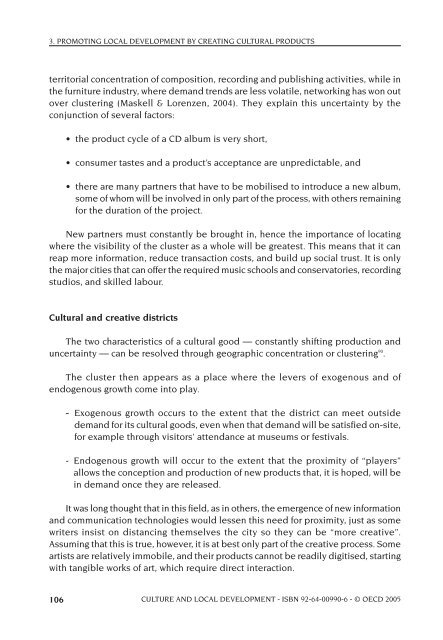OECD Culture and Local Development.pdf - PACA
OECD Culture and Local Development.pdf - PACA
OECD Culture and Local Development.pdf - PACA
You also want an ePaper? Increase the reach of your titles
YUMPU automatically turns print PDFs into web optimized ePapers that Google loves.
3. PROMOTING LOCAL DEVELOPMENT BY CREATING CULTURAL PRODUCTS<br />
territorial concentration of composition, recording <strong>and</strong> publishing activities, while in<br />
the furniture industry, where dem<strong>and</strong> trends are less volatile, networking has won out<br />
over clustering (Maskell & Lorenzen, 2004). They explain this uncertainty by the<br />
conjunction of several factors:<br />
• the product cycle of a CD album is very short,<br />
• consumer tastes <strong>and</strong> a product’s acceptance are unpredictable, <strong>and</strong><br />
• there are many partners that have to be mobilised to introduce a new album,<br />
some of whom will be involved in only part of the process, with others remaining<br />
for the duration of the project.<br />
New partners must constantly be brought in, hence the importance of locating<br />
where the visibility of the cluster as a whole will be greatest. This means that it can<br />
reap more information, reduce transaction costs, <strong>and</strong> build up social trust. It is only<br />
the major cities that can offer the required music schools <strong>and</strong> conservatories, recording<br />
studios, <strong>and</strong> skilled labour.<br />
Cultural <strong>and</strong> creative districts<br />
The two characteristics of a cultural good — constantly shifting production <strong>and</strong><br />
uncertainty — can be resolved through geographic concentration or clustering 90 .<br />
The cluster then appears as a place where the levers of exogenous <strong>and</strong> of<br />
endogenous growth come into play.<br />
- Exogenous growth occurs to the extent that the district can meet outside<br />
dem<strong>and</strong> for its cultural goods, even when that dem<strong>and</strong> will be satisfied on-site,<br />
for example through visitors’ attendance at museums or festivals.<br />
- Endogenous growth will occur to the extent that the proximity of “players”<br />
allows the conception <strong>and</strong> production of new products that, it is hoped, will be<br />
in dem<strong>and</strong> once they are released.<br />
It was long thought that in this field, as in others, the emergence of new information<br />
<strong>and</strong> communication technologies would lessen this need for proximity, just as some<br />
writers insist on distancing themselves the city so they can be “more creative”.<br />
Assuming that this is true, however, it is at best only part of the creative process. Some<br />
artists are relatively immobile, <strong>and</strong> their products cannot be readily digitised, starting<br />
with tangible works of art, which require direct interaction.<br />
106 CULTURE AND LOCAL DEVELOPMENT - ISBN 92-64-00990-6 - © <strong>OECD</strong> 2005














